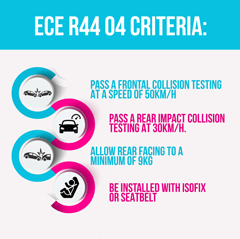CRASH TEST RATINGS AND REVIEWS EXPLAINED
Car seats are life saving devices, and not all car seats are created equally. In this article we will show you why independent crash testing is something you should know about and what certifications to look for when choosing a car seat.

WHAT IS INDEPENDENT CRASH TESTING?
You might wonder why car seats vary so greatly in price, and if it is worth forking out extra when they all essentially serve the same purpose.
Car seats are life saving devices, and not all car seats provide the same levels of protection. It’s not to say that expensive seats necessarily provide better protection and vice versa. That’s where independent crash testing comes in.
On our FaceBook group where we provide free advice; Car Seat Support South Africa, the term “independent crash testing” comes up often; a term South Africans were not familiar with until recently.
In South Africa we follow European car seat regulations. All car seats legitimately sold here need to pass the ECE R44/04 or R129 crash testing. You will find an orange ECE sticker on your car seat to confirm that the car seat complies with the basic safety requirements as set out in the European safety standard.
Car seats have to be approved by the NRCS in order to be sold legally in South Africa. If a car seat is not on the homologated list, it may be a fake or illegal seat. It doesn't get updated online very often unfortunately, so doesn't always show the most recently added car seats. The ECE results are not published and the public have no way of knowing how these car seats fare during crash testing; whether they scraped through or exceeded the testing criteria.
All infant, toddler and booster seats sold at Precious Cargo have been independently crash tested and score well for safety.
ECE Crash Testing
Here is a breakdown of the mandatory ECE crash testing requirements:
ECE R44/04

Under Regulations ECE R44/04, car seats must:

- Pass a frontal collision testing at a speed of 50km/h
- Pass a rear impact collision testing at 30km/h.
- Allow rear facing to a minimum of 9kg
- Be installed with isofix or seatbelt
UN R129/I-SIZE
In Europe, the new UN legislation R129, also known as i-Size, was passed in 2013.The Regulation applies to children between 1-4 years old.

These amendments to R129 crash testing will ensure better protection for babies by encouraging rear facing to a minimum of 15 months, as opposed to the 9kg minimum rear facing limit of R44/04 regulations.
The changes to R129 also improve side impact protection standards on car seats.
It is easier to install isofix seats, which reduces the risk of the car seat being incorrectly and unsafely installed. Furthermore, i-Size aims to improve the compatibility between isofix vehicles and car seats, so that all i-Size car seats will eventually fit all vehicles with isofix.
With i-Size seats being classified by weight AND height, it is easier to chose the correct car seat suitable for your child.
From April 2008, all child car seats that were manufactured before 1995 and approved to the ECE R44/01 and 44/02 standard are no longer legal and must not be used or sold. Only seats displaying the European Standard orange label, indicating approval to the Standard to ECE R44/03, ECE R 44/04 or i-Size (UN R129) may be legally used. However, car seats approved to R44/03 are likely to be older than 10 years and are therefore considered to have expired and be unsafe for use.
I-Size seats must:

- Provide mandatory rear facing up to 15months.
- Pass a frontal collision test at a speed of 55km/h
- Pass a rear impact collision test at 30km/h
- Pass a rollover test
- Be installed with isofix
- Be classified according to a child’s height rather than weight alone.
- I-Size car seats should fit all cars with isofix
ADAC Car Seat Safety Test
WHAT IS ADAC?
ADAC (Allgemeiner Deutscher Automobil-Club) is an automobile club in Germany that selects car seats for independent crash testing. Car seat manufacturers do not pay for the testing nor do they volunteer for the testing.
The results are published in German and the translated safety reviews have been uploaded into relevant photo albums on Car Seat Support South Africa . If the car seat you are looking for is not listed under the relevant photo album, it has most probably not been independently crash tested. All the infant, toddler and booster seats we sell at Precious Cargo have been independently crash tested and score well for safety.
ADAC ASSESSES CAR SEATS ON 5 POINTS:
Safety
Frontal impacts at 64km/h and side impacts at 50km/h are with a four-door vehicle body shell mounted to a test sledge. Impact loads are measured on differently sized child dummies. Belt routing, size adjustment, seat stability and head support are assessed subjectively.
Service/Usability
A child seat is installed in a car for test purposes with the aim of identifying the misuse potential. Testing includes ease of buckling up and unstrapping the child/dummy, installation, removal and adaptation of the seat and a check of the instruction manual.
Pollutants
The test the seat for harmful chemicals and/or pollutants
Comfort
During the test installation of the seat, ADAC verify’s the leg support, upholstery or uncovered parts and the child’s field of vision.
Processing/Use
Several testers check seat cleaning and assess workmanship.
ADAC verdict

The overall rating only relates to safety and ease of use, with the lower rating tipping the scale.
Car seats that are more difficult to install are penalized, especially extended rear facing car seats that require tethering, as this may result in incorrect installation. However, by following the manual, the manufacturer’s installation videos and online support from experts in the field, it is possible to install these seats correctly and safely in most instances.

Swedish Plus Test
What is the swedish Plus test
The Plus Test is conducted at the Road Safety Institute in Linköping University, Sweden, by VTI. Car seat manufacturers volunteer to have their car seats undergo the stringent testing conducted by Swedish Plus Test.
It is the only test in the world that measures the force load upon the child’s neck in a frontal collision. This is why forward facing car seats will never pass the Swedish Plus Test; the crash forces to the neck are too high when forward facing.
Sweden prides itself for having the lowest child mortality rate in the world. This is not surprising as they keep their children rear facing for approximately 5-7 years.
THE SWEDISH PLUS TEST is:

- Carried out with a speed of 56.5 km/h
- Neck load is carefully assessed by measuring the crash forces applied to the dummies neck with sensors
- Very short braking distance, which makes the impact on the car seat brutal. The shorter the braking distance, the more violent the forces become.
Conclusion
A suitable car seat that is undamaged is certainly better than no car seat, and we fully appreciate that many South Africans are not able to afford the highest scoring car seats. It’s still important to note that Car Seat Technicians recommend that for children under 4 years “any rear facing car seat used correctly, will be safer than a forward facing car seat – no matter what testing it has been through” (Therese Gilbert, qualified car seat technician).
It is important to note that it is not safe to use a car seat over its maximum approved weight in each category. Please refer to your manual for clarification of the rear facing, forward facing and/or booster weight/height limits.
When choosing a car seat, read through the safety reviews and narrow it down to 2-3 car seats that score reasonably well and fit your budget.
If possible, fit them in your vehicle/s according to the manual before purchasing to see which seat installs most securely in your particular car. Not all car seats fit all cars, and an incorrectly high scoring car seat is possibly no safer than a properly installed low scoring seat.
